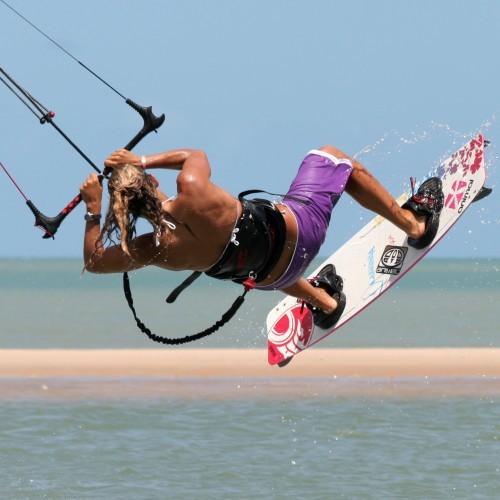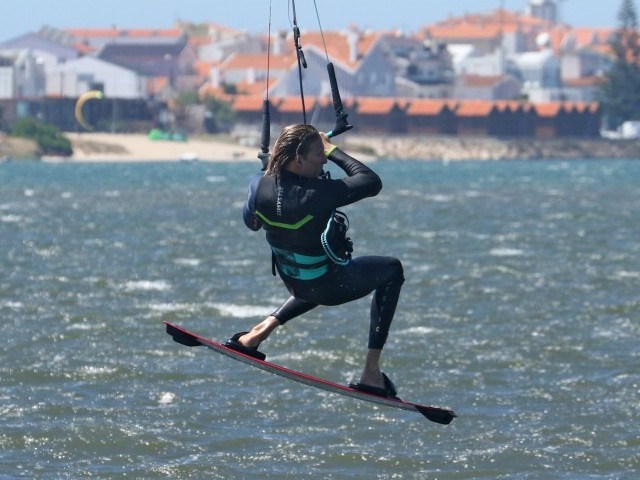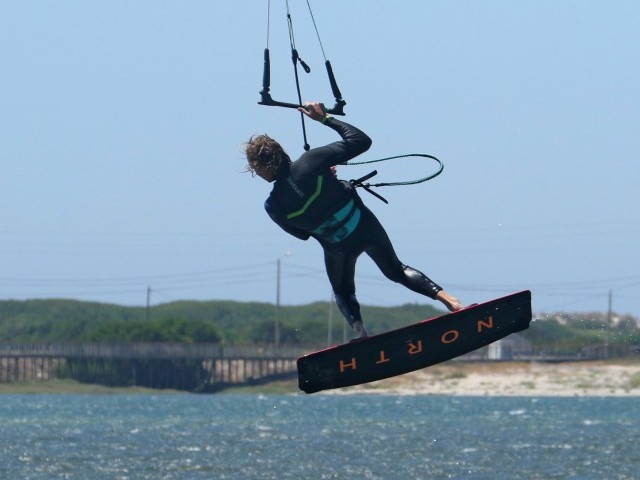
Hooked in Back to Blind
Technique / Intermediate
Introduction
Continuing from last issues hooked in to blind move, this time around we will focus our attention on the back to blind. As we said before training these moves will broaden your horizons and gives you something to show off even when your kite is feeling that bit too large.
Just like the hooked in front to blind we’re expecting you to have a good, solid pop to blind, and suggest that you practice popping higher and waiting longer before throwing the blind, so that you can really separate this movement from whatever else you are doing.
The other part of your game, which you need to give some serious thought to, is your trusty back loop. It will be worth your while practicing slow controlled popped back loops, as going to blind from an uncontrolled, over rotating spin will be more than difficult. What this means is that you should be concentrating on your take off, putting more effort into popping, as opposed to throwing your head around and spinning quickly.
Pic A. In this picture Karine has just taken off. The first thing to note is the position of her head. Karine is looking through her arms and not over her shoulder. If you’re ready to try this sort of move, you should be confident that you can get around a back loop without having to look for the landing. By looking straight ahead Karine will rotate slower, and it will be easier to stop her rotation and turn the other way.
The take off should also be earlier than you might be used to for a back loop. Once again as you are popping you should be going off the wind first by flattening your board. This should then mean that you can turn up into the wind sufficiently to induce the back rotation. It also will allow you to pop up off the water before you actually turn into the wind. The result being that you will have more time in the air before the imminent blind bit! If you carve correctly with a straight front leg, and pop hard off your back leg you will start your rotation with your legs and body stretched out. You will need this extra time in the air to bring everything back together.
Pic B. Here Karine has almost completed her back loop. Her board is almost 360˚ around from her pre take off downwind path. Her aim here is to stop her rotation in preparation for the throw to blind.
As tempting as it may be to start turning the body the other way, you first need to get ready to give yourself a chance of landing on your feet and not your derriere. From take off to here, Karine has pulled the bar in with her arms and brought her knees up towards the bar, effectively pulling her hands and knees together. By doing this Karine brings her body under the bar, brings her board up and positions the board downwind of the bar, her shoulders and her hips. Meaning that when she lands the board will be between her and the kite. If she didn’t crunch like this she would be in danger of leaving the board behind her and therefore falling onto her back when landing.
Also by pulling on the bar, Karine keeps power in the kite, so she drifts downwind, which in turn will make the landing easier. You can see that she is still looking through her arms. She is now ready to throw the blind.
Pic C. Karine now enjoys the fruits of her labour. Having got everything into the correct position she can now confidently rotate her body to blind. In simple terms she is just turning her body back the other, and because of where the board was positioned previously, she will end up with the board underneath her, once she has turned. There is no magic trick in the throw to blind, but plenty in the preparation.
You can see that Karine keeps the bar in tight with her front hand. This stops the kite and bar leaving her behind, as she continues to be pulled by the tension in the lines. To turn Karine has released her back hand, which she then throws around behind her to help with the rotation. She also turns her head aggressively to look back, whilst pushing her front foot downwind and keeping her back foot tucked up under her bottom. This way the nose of the board will touch down first and pivot itself and the rest of the board further around for a clean reception. If Karine kept the front foot up or let the back foot down she would land flat on the board. The board would then stop abruptly and she would pile into the water.
Pic D. Karine is just touching down. You can see that she landed old nose first, which enables the board to pivot more downwind. She also lands flat on the board, not on an edge. Trying to land on an edge at speed just doesn’t work, the flat board will soak up the landing and propel you forward, keeping your momentum. Karine is most definitely looking back, with her weight over her old front foot. Even though she intends to continue riding blind, she needs to settle first before thinking of grabbing the bar and having a look where she is going.
Top Tips
As with all pop tricks, where you start is where you finish. You cannot land across the wind, so you need to land slightly off the wind. If you bear away before popping this is your start course, and you’ll land going the same way.
Some riders try and stop their rotation very early and drop down to blind. If this takes you fancy by all means try it. However style wise and satisfaction wise you’ll probably feel better and have fewer new steps to learn if you go for a nearly full back to blind. And even more importantly, by finishing the back loop you should be able to get the board in between yourself and the kite.
Following the Sequence 2
- Pic 1. Karine has her kite just below 11 o’clock, she has come in with enough speed to give her momentum when she lands, and she went off the wind before carving up.
- Pic 2. Karine pops up off the water before she turns too far into wind, whilst keeping her head looking straight through her arms.
- Pic 3. As she explodes up into a slow back loop Karine looks upwind and trusts her take off to give her enough rotation for the back loop.
- Pic 4. As she rotates Karine pulls her hands down towards her chest and brings her knees and therefore board up towards the bar.
- Pic 5. As she completes the back loop Karine pulls her hands and knees together.
- Pic 6. With the board now coming forward towards the kite Karine releases her back hand and starts to turn to blind.
- Pic 7. Keeping her back foot tucked up Karine turns her head and shoulders forcefully against the back loop, whilst keeping the bar pulled in and near to her.
- Pic 8. Karine lands on the old nose of the board, so that it can pivot, and she lands flat over the board, not on an edge. Karine has all her weight, knees, hips, shoulders and head committed over her old front foot.
Once Karine is settled she can reach around and grab the bar, have a look where she’s going and get back onto an edge, see the video.
Common Problems
Stopping when you land. You need momentum going into this move so make sure you have enough speed when you take off. Also check that your kite is not high and that it doesn’t drift up during the back loop as it needs to pull you through the move. Try giving a little tug on your front hand just before releasing the back hand.
Falling downwind of the board when you land. Unfortunately this could be for a number of reasons. Firstly make sure you keep the bar held in close and don’t release you back hand until you have completed the back loop. Secondly make sure that you keep your back foot tucked up under your bum, so that the board can pivot on landing.
Keystones
- Speed off the wind
- Pop early
- Look through your arms
- Crunch hard
- Keep back leg up
This technique article was in Issue 25 of IKSURFMAG.
Related
By Christian and Karine
Christian and Karine have been working together as a coaching team, running improver to advanced kitesurfing clinics since 2003.




























